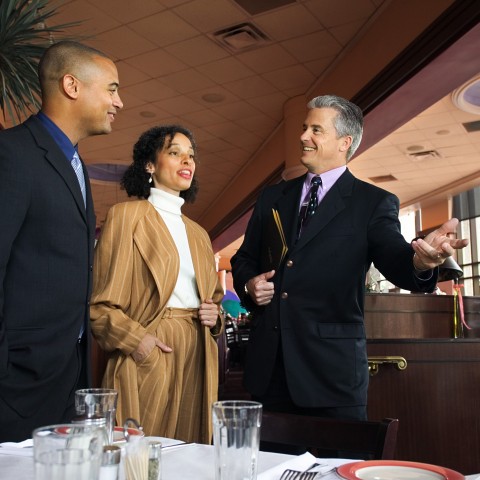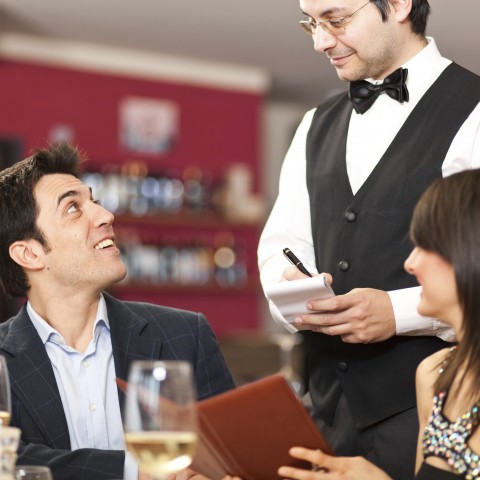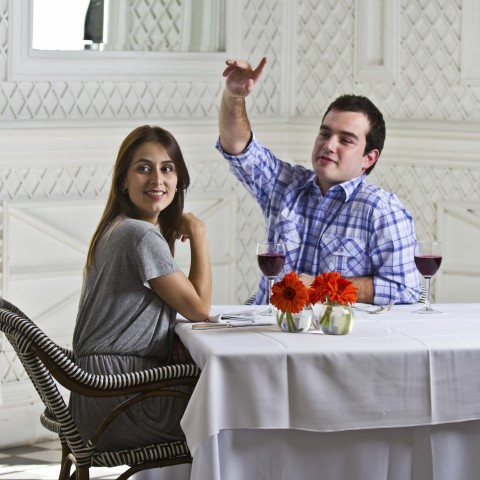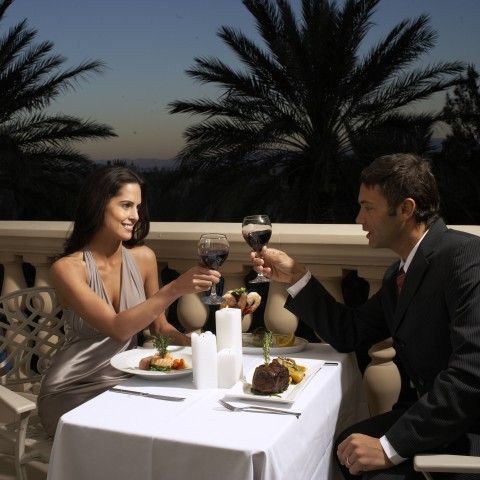
Going to a restaurant is probably one of the favorite things people do when they are in a foreign country. It’s a great way to go out, enjoy some new food and discover a new hip and trendy restaurant. However, when you don’t speak the language fluently, the whole experience can be unnecessarily stressful.
How do things work around here? How can I order? And how much should I tip? Knowing the Dutch restaurant vocabulary and phrases is one thing, but learning about the ins and outs of Dutch dining will truly take you to the next level.
In this article, we’ll go through the three steps of going to a restaurant in the Netherlands and, for each phase, we’ll list the most common Dutch phrases for restaurants, as well as the restaurant etiquette and unwritten rules you need to know.
So let’s learn how to order food in Dutch and start to really enjoy the Dutch culinary experience.

 Table of Contents
Table of Contents
1. Before Dining
A- Booking a Restaurant: When and How?
Making a reservation in a Dutch restaurant is not always necessary, as you can often show up unannounced. However, without a booking, you will not have the guarantee that a table will be available. This is especially the case for the more popular restaurants, or if you’re planning to go out during busier nights like Friday or Saturday night.
So, is it really necessary to make a reservation at a restaurant in the Netherlands? No, but it can be a great way to make sure that your night goes as planned. So how to make a booking in a Dutch restaurant? Some restaurants have their own booking system on their official website, while others use The Fork or other similar third-party services. In most cases, you can also make a phone call, if you prefer to do so. Booking information and phone numbers are usually available on the restaurant information on Google Maps.
B- Conversation Example
Would you like to make a reservation by phone? Let’s learn restaurant phrases in Dutch grammar on reservations, between a client and a restaurant employee:
| Hallo, Restaurant “De Bolle Beer”, hoe kan ik u helpen? (“Hello, “De bolle beer” restaurant, how can I help you?”) Hallo, ik wil graag een tafel reserveren voor morgenavond. (“Hello, I would like to book a table for tomorrow evening.”) Oké. Voor hoeveel personen? (“Okay. For how many people?”) Voor vier personen. (“For four people.”) Wilt u binnen of buiten eten? (“Would you like to eat inside or outside?”) Buiten als dat kan. (“Outside if that’s possible.”) Oké. Voor hoe laat? (“Okay. At what time?”) Om half acht. (“At half past seven.”) Wat is uw naam? (“What is your name?”) Mijn naam is Sofia Real. (“My name is Sofia Real.”) Oké Sofia. Morgenavond om half acht, vier personen, buiten op het terras. De reservering is gemaakt. (“Okay Sofia. Tomorrow night at half past seven, four people, outside on the terrace. The reservation has been made.”) Perfect. Heel erg bedankt! Tot morgen. (“Perfect. Thank you very much! See you tomorrow.”) |
- ➜ Do you still get nervous when calling in Dutch? Then make sure to have a look at our Useful Phrases For a Phone Call vocabulary list. It’s freely available on DutchPod101.
Do you prefer to send an e-mail or message to make the reservation, then you can also write the following message:
| Hallo, ik wil graag een tafel reserveren voor morgenavond om 19:30u voor 4 personen. Mijn naam is Sofìa Real. (“Hello, I would like to reserve a table for 4 people tomorrow evening at 7:30 pm. My name is Sofia Real.”) |
2. During Dining
So, you know which restaurant to go to, you might even have made a reservation. Let’s now see some common Dutch phrases for restaurants, such as asking for your table, asking for the menu, and how to order food in Dutch.
A- Asking for Your Table

Did you already book a table? Then this part of the process will be as simple as introducing yourself when entering the restaurant. Let’s learn these restaurant phrases in Dutch grammar:
| Hallo, ik heb een reservering op naam van Jack Smith. (“Hi, I have a reservation under the name of Jack Smith.”) Goedenavond, ik heb een reservering op naam van Jack Smith, voor zes personen. (“Good evening, I have a reservation under the name of Jack Smith, for six people.”) |
And you will be shown your table.
Didn’t you make a reservation? Then you can ask the following question when you enter the restaurant:
| Hallo, hebben jullie nog een tafel vrij voor vier personen? (“Hello, do you have a table available for four people?”) Ja, we hebben nog een tafel vrij op ons terras. Loop maar met me mee. (“Yes, we still have a table available on our terrace. Come with me.”) |
The host waiting at the entrance could also ask you directly some questions, such as this eating at the restaurant phrases in Dutch:
| Goedenavond, komen jullie om te eten? (“Good evening, are you here to eat?”) Ja. (“Yes.”) Nee, alleen om wat te drinken. (“No, just for a drink.”) |
| Wilt u binnen of buiten eten? (“Would you like to eat inside or outside?”) Binnen, alstublieft. (“Inside, please.”) |
| Voor hoeveel personen? (“For how many people?”) Voor twee personen? (“For two people?”) Voor drie personen. (“For three people.”) |
- ➜ You can find more words and practice your pronunciation with our vocabulary list on Restaurants.
B- Asking for the Menu
Many restaurants in the Netherlands already have the menu on the table or give you the menu when you sit down. But in case it’s not there, they forget, or they are really busy, you might have to ask for it.
| Pardon. Mag ik de menukaart zien? (“Excuse me. Can I see the menu?”) |
Dutch menus don’t always follow a standard pattern. However, you will usually find the following components: voorgerechten or “appetizers,” soep, which is “soup,” hoofdgerechten, meaning, “main entrées,” dranken, which is “drinks,” and of course the nagerechten, your “desserts.”
- ➜ Are you missing a fork or a spoon? After learning Dutch food vocabulary on Food Utensils and Tableware, you will be able to ask for it without hesitating.
C- Ordering Food and Drinks

Now the most exciting time has arrived: you can order that basic food in Dutch. It’s time to move on to some eating at the restaurant phrases in Dutch. But how to order food in Dutch? Don’t be nervous, ordering is usually fairly easy as you can just refer to the menu.
In the Netherlands, after the waiter shows you your table, he or she will usually first ask you what you want to drink.
| Wat wilt u drinken? (“What do you want to drink?”, singular or formal plural) Wat willen jullie drinken? (“What do you want to drink?”, casual plural) Ik wil graag een appelsap, alstublieft. (“I’d like an apple juice, please.”) Niets voor mij. (“Nothing for me.”) Misschien later. (“Maybe later.”) |
- ➜ What drink would you like to order in Dutch? Have a look at our free vocabulary list on Drinks, on DutchPod101.
When you look ready to order, the waiter may ask you:
| Heeft u een keus gemaakt? (“Have you made a choice?”) |
To which you may respond with one of these ‘eating at the restaurant’ phrases in Dutch:
| Nee, we hebben nog wat meer tijd nodig. (“No, we need a little more time.”) De varkenshaas, wat is dat? (“The varkenshaas, what is that?”) Ja, ik wil graag de pompoensoep vooraf en daarna de steak met frietjes als hoofdgerecht, alstublieft. (“Yes, I’d like the pumpkin soup first and then the steak and fries for the main course, please.”) Ja, ik wil graag de saté als hoofdgerecht en de chocolade mousse als nagerecht, alstublieft. (“Yes, I would like the saté as a main course and the chocolate mousse for dessert, please.”) |
When you order in the Netherlands, you usually say alstublieft (“please”) after your order.
Are you not sure what to order? You can always ask the staff for recommendations. The appropriate question in such a situation would be Wat raadt u aan? (“What do you recommend?).
If you have any allergies or a special diet, then you might also want to say or ask:
| Ik ben allergisch voor pinda’s. (“I’m allergic to peanuts.”) Zitten er pinda’s in dit gerecht? (“Are there peanuts in this dish?”) Wat zijn de vegetarische gerechten? (“What are the vegetarian dishes?”) Hebben jullie vegan gerechten? (“Do you have vegan dishes?”) |
- ➜ For more sentences on how to order food in Dutch, you may want to check our vocabulary list with Useful Phrases and Vocabulary for Ordering Food.
3. After Dining
Once you have enjoyed your meal and the waiter sees that you have finished, he or she will probably come to your table and kindly ask you one of the following questions:
| Wilt u nog iets anders? (“Would you like anything else?”) Nee, bedankt. We zijn helemaal voldaan. (“No thanks. We are completely satisfied.”) Was alles naar wens? (“Was everything to your liking?”) Ja het was heerlijk, dankuwel. (“Yes, it was delicious, thank you.”) Wilt u nog een kopje koffie? (“Will you have a coffee?”) Ja, graag. (“Yes, please.”) |
A- Asking for the Bill

If the waiter asks you if you need anything else, you can also ask for the bill:
| De rekening alstublieft. (“The bill, please.”) Kunnen wij de rekening krijgen? (“Can we get the bill?”) Ja, ik zal de rekening voor u halen. (“Yes, I’ll get the bill for you.”) U kunt direct aan de balie betalen. (“You can pay directly at the counter.”) |
Then, when it’s time to pay:
| Willen jullie apart of samen betalen? (“Do you want to pay separately or together?”) Ik zal voor iedereen betalen. (“I will pay for everyone.”) Apart, alstublieft. (“Separately, please.”) |
B- What About the Tip?
The tips in the Netherlands are very rarely included in the price, so it is polite to give tips in restaurants, pubs, and some cafés. About ten to twelve percent would be appropriate. Dutch waiters don’t survive on tips, but they’re rarely paid very well, so a tip is a welcome bonus to their wage.
Tips are usually left on the table in the form of coins, a bill, or in a dedicated tip box at the counter. But you could also ask to add a certain amount or 10% to the bill when paying by card: Voeg maar tien procent toe als fooi. (“Just add ten percent as a tip.”)
- ➜ Would you like to see more common restaurant vocabulary and phrases with recorded examples to work on your pronunciation? Why not stop by our vocabulary list on Key Phrases for Restaurants.
4. How DutchPod101 Can Help You Learn More Dutch

In this guide, you have learned everything you need to know when going to a Dutch restaurant. You now know how to make a reservation and how to order food in Dutch. For each step, you know the tips and tricks, as well as Dutch restaurant vocabulary and phrases. Did we forget some specific situations you’d like to learn more about?
You can start practicing speaking Dutch and rehearsing these common Dutch phrases for restaurants by checking out the free vocabulary lists on DutchPod101.com. Each list contains a recorded pronunciation of the words and phrases it covers, making them perfect for getting your pronunciation just right! In addition, we provide a variety of free resources and audio/video lessons for learners at every level.
Would you like some special attention to your Dutch language learning? Remember that we also offer a Premium PLUS service with personal 1-on-1 coaching: MyTeacher. Let your private teacher help you with Dutch vocabulary, pronunciation, grammar, and much more. You’ll receive personalized exercises, constructive feedback, and interactive assignments.









